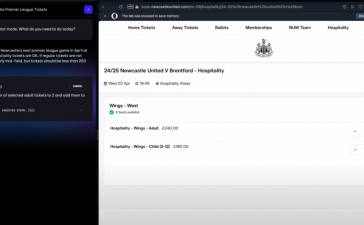It looks like the cookie won’t be crumbling after all.
Google is scrapping its tumultuous, years-long effort to eliminate third-party cookies on Chrome.
In an announcement made Monday, the search giant indicates that it plans to keep third-party cookies up and running for those who don’t disable them. However, to enhance user privacy while preserving advertising effectiveness, Google plans to roll out a new solution: a one-time prompt that enables users to set preferences that will apply across Google browsing experiences.
“We are proposing an updated approach that elevates user choice,” wrote Anthony Chavez, vice-president of Privacy Sandbox, in a blog post published today. “Instead of deprecating third-party cookies, we would introduce a new experience in Chrome that lets people make an informed choice that applies across their web browsing, and they’d be able to adjust that choice at any time.”
Third-party cookies, small data files that track individual users’ activity across the web – generally without user consent – have long been used to gather information and serve highly targeted ads. They’ve been blocked from browsers, including Mozilla Firefox and Safari, to enhance user privacy.
Google, which commands more than 90% of the search market, however, has dragged its feet as it seeks to balance user privacy with advertisers’ demands. In January 2020, Chrome promised to phase out the technology “within two years.” However, as it became apparent that the ad industry was ill-prepared for the change, Google extended its timeline. Since then, the tech giant has pushed back its deadline two more times – most recently, in April of this year, citing regulatory concerns about Google’s Privacy Sandbox, the company’s suite of proposed cookie alternatives. Just months earlier, as testing began, Google had disabled third-party cookies for 1% of Chrome users globally.
Powered by AI
Explore frequently asked questions
The decision to introduce a new user “experience” in lieu of sunsetting third-party cookies was made after much consideration of feedback “from a wide variety of stakeholders, including regulators like the UK’s Competition and Markets Authority (CMA) and Information Commissioner’s Office (ICO), publishers, web developers and standards groups, civil society, and participants in the advertising industry,” wrote Chavez.
Regulators, in particular, have been a thorn in Google’s side. In January, the UK’s antitrust enforcer, the CMA, flagged 39 unique concerns about Google’s Privacy Sandbox.
Outside of antitrust concerns, recent research has also indicated that Google’s Privacy Sandbox terms may, ironically, violate privacy laws.
Google says it claims it will continue working with the CMA and other regulatory bodies to hone its Privacy Sandbox offerings and its new privacy prompt. “We’re discussing this new path with regulators and will engage with the industry as we roll this out,” Chavez wrote.
A CMA spokesperson reacted to Google’s revised plans today, saying in a statement: “We intervened and put in place commitments in 2022 because of concerns that Google’s Privacy Sandbox proposals could distort competition by causing advertising spend to become even more concentrated on Google’s ecosystem at the expense of its competitors. We will need to carefully consider Google’s new approach to Privacy Sandbox, working closely with the ICO in this regard, and welcome views on Google’s revised approach – including possible implications for consumers and market outcomes.”
Outside of regulators’ concerns, the advertising and publishing industry has been exerting additional pressure on Google. Among the sector’s key concerns is Privacy Sandbox’s impact on advertising effectiveness and campaign performance.
In February, the IAB Tech Lab, a nonprofit digital advertising consortium, released a 106-page gap analysis that indicated that transitioning from third-party cookies to Google’s Privacy Sandbox would substantially hinder most current forms of digital advertising. According to the analysis, only a fraction of the 44 basic digital advertising use cases reviewed would remain feasible with the APIs provided by the Sandbox. Google disputed the IAB Tech Lab’s assertions, claiming the group’s report was rooted in “many misunderstandings and inaccuracies.”
Other major industry players have raised similar concerns. After two months of testing, adtech firm Criteo determined that Google’s Privacy Sandbox, the company’s suite of proposed cookie alternatives, would erase publishers’ ad revenues by 60%.
Now, with plans to expand third-party cookie user controls in Chrome, Google is maintaining its argument that ad performance will remain strong even in lieu of cookies.
The company says that recent tests conducted by Google Ads suggest that Privacy Sandbox APIs can deliver strong results. In experiments run between January and March of this year, which employed Privacy Sandbox tools, including its Topics API, Protected Audience API and Attribution Reporting API, Google saw an 89% recovery of ad spend in Google Display Ads and an 86% recovery of ad spend in Display & Video 360 (DV360). For performance campaigns focused solely on conversions, Google says it recorded a 97% recovery in conversions per dollar for Google Display Ads and a 95% recovery for DV360.
Suggested newsletters for you
Remarketing campaigns, meanwhile, showed a 55% advertiser spend recovery in Google Ads and 49% in DV360. This comparatively low recovery rate, Google says, can be attributed to remarketing’s reliance on third-party cookies for precise personalization – as well as limited inventory due to the fact that many supply-side platforms are not testing Privacy Sandbox APIs. In its research, Google found that campaigns that combined remarketing with other strategies like optimized targeting and affinity audiences witnessed better returns.
Further experiments found that publishers could mitigate revenue losses from the removal of third-party cookies by using Privacy Sandbox APIs in combination with other approaches, like first-party data. Without Privacy Sandbox, Google Ad Manager’s programmatic revenue dropped by 34%, and Google AdSense’s revenue fell by 21%. When Privacy Sandbox was implemented, however, these dips were 20% for Google Ad Manager and 18% for Google AdSense.
“Our latest Privacy Sandbox experiment showed overall progress in driving performance without third-party cookies when using a combination of privacy-preserving signals, with room for continued improvements,” a Google Ads spokesperson tells The Drum. “While our findings are directional, we expect results to keep evolving as others across the industry adopt the APIs and enhance their use.”
Chavez says that Google will continue developing Privacy Sandbox APIs and will also debut new privacy measures. For instance, the company plans to offer IP address obfuscation in Chrome’s Incognito mode.
“We expect that overall performance using Privacy Sandbox APIs will improve over time as industry adoption increases,” Chavez wrote. “At the same time, we recognize this transition requires significant work by many participants and will have an impact on publishers, advertisers, and everyone involved in online advertising.”
Google plans to continue refining Privacy Sandbox technologies in the coming months.
Subscribe to Kendra Barnett’s weekly media briefing, as well as The Drum’s daily newsletter, here.












